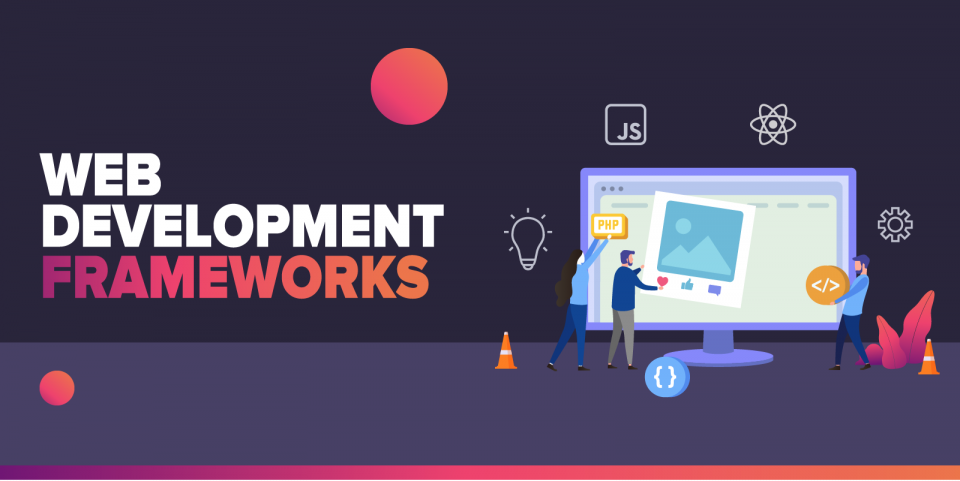In the web development industry, you will find numerous frameworks for creating web-based applications. But it is very tricky and complex to select the right web development framework from them. If you are running an enterprise, then choosing the right framework that will be supported and maintained for the next five years and fit into your company goals and resources is very important. If you are a developer looking for a job and want to choose a high-demand framework in the job market that can also fit into your profile, keep reading this article.
1. React
Nowadays, frameworks that are based on JavaScript are dominating the market of web development. In this, React is coming at the top. It is considered the most disruptive and popular web development framework. Facebook has developed React, an elementary JavaScript library for implementing the web view layer, based on the component and released in 2013. It differs a lot from the JavaScript framework, and it promotes the process of one-way data binding. In a short period, react has become very popular among developers and enterprises. Today it is the leading framework for client-side web development.
2. Vue.js
Evan You, who is an ex-Google engineer, has developed the Vue.js framework. It is a Model-view-view-model JavaScript-based web development framework. This client-side framework was released in 2014. In this framework, you will find the combination of the AngularJS parts and other Virtual DOM parts. Vue.js has grown as a community-driven web framework. In many ways, it has taken the middle path between Angular and React and is an excellent alternative for React and Angular.
Key Features:
- Vue.js is highly reliable when it comes to end to end application development functionality. This may include Angular and React. You can also do the state management with vue.js. The CLI of vue.js will help in creating a new vue.js application having convention-over-configuration.
- It has lowered the barrier of frontend development, which is based on JavaScript. It will offer a very premium quality of documents.
- It is considered the best JavaScript framework for web app development. It will offer two-way reactive data binding like Angular, and it is also supporting the event sourcing and virtual Dom like React. The community drives it, and it is not dependent on the needs of a single organization.
3. Angular
After the failure of the AngularJS, Google has released Angular in 2016, which is client-side, an end-to-end web framework that is offering dirty checking, two-way data binding, and convention over configuration. It is also used as TypeScript, a native programming language, and has a pivotal role in popularizing TypeScript. Angular is very stable, and there is no significant change in the last five years.
Angular is also focused on robustness and stability over innovation. Due to this, it is considered perfect for the development of enterprise applications.
Key Features:
- Angular is the framework in which you will get the end-to-end experience of application development. Angular CLI is the best CLI in web development and will help in creating Angular projects.
- It is a very heavyweight client-side framework which is having a very steep learning curve. It is considered the most secure client-side web development framework. It is offering the features like DOM sanitation, which is among the most secured features.
- It is used for developing the apps for various deployments like Mobile Web, Web, Native Mobile and desktop. Google backs angular, and it is extensively used in the industry as the supported tooling.
4. Spring
At the beginning of the century, most companies were using the Java Enterprise framework for web developments. But due to various limitations of the J2EE, the need for heavy configuration, cumbersome, and the setup time for creating simple applications also require serious efforts.
To overcome all these shortcomings, Rod Johnson in 2002 had created Inversion of Control, which is the spring framework, and the server-side web framework. This has grown with time, and its primary focus is on the development of Java-based applications. The best part of spring is that it will evolve with changing landscape, and it is having a significant role in making java relevant in the age of cloud computing.
Key Features:
- It is rendered server-side. Enterprise-grade, primarily MVC web framework having the support of reactive and asynchronous programming. It is also leading in the web framework, which is based on the JVM.
- It is popularized as Annotation, Dependency Injection, and Inversion of Control. There are many other frameworks for those who have copied all these concepts later.
- Web framework based on spring is part of a larger spring ecosystem supporting the additional native cloud development, event-driven application development, batch processing, and many more.
5. Django
In 2005, Simon Willison and Adrian Holovaty created the server-side, python-based web framework that follows MTV’s architectural pattern. In the last decade, the popularity of Python has increased by bounds and leaps. This is directly affecting the adoption of Django. Besides this, various pleasant features have been offered in Django and are currently being used in server-side web frameworks.
Key Features:
- It is a rendered server-side, enterprise-grade, MTV web framework with additional support for reactive and asynchronous programming. As an admin of Django, it is offering the rapid development of applications.
- It is a battery included framework and has everything from Middleware, ORM, security, and caching, required for rapid application development having enterprise-grade quality.
- It is offering extensibility via pluggable apps in which third-party apps can be plugged quickly.
- It is also offering breakneck development. Django will work very seamlessly with Python, which is considered the largest ecosystem in the industry.
- Django is having the right balance of enterprise features and rapid application development. Due to this, it is the most popular server-side web development framework.
6. Ruby on Rails
In the early 2000s, web application development is differing a lot from today. J2EE, which is a Java-based web development framework, was de facto at that time. It is very heavyweight, and lots of plumbing is needed into it. The development of simple web applications also requires significant efforts. David Hanson has created Ruby on Rails, a server-side web development framework supported on the Ruby programming language and MVC pattern. Many novel ideas and concepts have been introduced in it, like Active Record Pattern, Don’t Repeat Yourself, and Convention over Configuration. Rapid Application development with the creation of database and migration and scaffolding views all made possible with Ruby on Rails. It is the most disruptive and influenced web development framework on this list.
Key Features
It is a server-side framework that is focused on the DRY, convention over configuration. It is also supporting the MVC architecture with reactive and asynchronous programming.
It is also a battery included framework. It offers everything from Database Migration, ORM, Caching, Middleware, and security, which are needed for rapid application development with quality of enterprise-grade.
7. ASP.NET Core
For fulfilling the needs of modern software development, Microsoft has modernized its Tech stack with modern, innovative, and futuristic design. Microsoft has reworked its flagship software development stack, ASP.NET, the most successful web application development. In 2016, Microsoft released ASP.NET Core, which is the successor of ASP.NET. These are a complete rework of the predecessor, and it is open source. It is a modular web framework running on multiple platforms and working seamlessly with modern JavaScript frameworks. This is a client-side framework.
Key Features:
- It is rendered server-side, enterprise-grade MVC framework. It is also supporting the reactive, asynchronous programming and runtime components.
- It can run on multiple platforms like Windows, cross-platform .NET Core, and .NET framework.
- It is modular in design, and there are various .NET libraries. The most popular client-side libraries for JavaScript like Angular, React, Ember.js, and Vue.js are all working very seamlessly with the ASP.NET core.
- It is designed for the development of large-scale applications and will be able to outperform the other web application frameworks.
- It has the best support of tooling like Visual Studio IDEs, which Microsoft also developed. It is offering rapid application development with the help of IDE and CLI.
8. Flask
In 2010, Armin Ronacher created the Flask which is a python-based web application development framework. Flask is an opinionated and micro-framework which does not need any libraries or tools. You can compare it with Express.js and not have any out of box support for securities, ORM, or Form validation. Flask is modular and has support for pluggable extensions. With Python, the Flask is also enjoying remarkably high popularity in the web development framework space.
Key Features:
- It is a micro web framework that is rendered on the server-side.
- There are pluggable modules for the extension of the core Flask framework.
- It is a wrapper framework that uses Werkzeug as HTTP handling and Jinja2 as the template engine.
- Flask is also providing the CLI, which is helpful to developers in accessing the App. CLI is also extensible.
- It is not a very opinionated and end-to-end framework.
- Flask is the second most popular web development framework. It is coming just behind Django.
- In GitHub, it is the 6th most starred web framework. According to a survey of StackOverflow, it is the most loved web development framework.
9. Express.js
TJ Holowaychuk has created the server-side Express.js, MVC based web framework based on Node.js runtime JavaScript. The stable version of this web development framework was released in 2010. This framework was influenced by Sinatra, which is also offering similar kinds of functionalities. Developers are using Express.js for developing the REST-based web application. This is rendered server-side and having complete web applications that are pluggable with the view layer.
Key Features:
- It is a server-side rendered, minimalistic web framework and supports Node.js, a server-side framework.
- It is mostly used in the backend and supporting end-to-end web application development. It is also supporting the MVC pattern with a layer of 14+ template engine.
- It is supporting the routing, middleware, and templating. With active development of 10+ years, it is very stable, mature, and highly performant.
- It is including the batteries and not having any support for securities and ORM.
- There was a meteoric rise in Node.js’ popularity of Node.js in the last decade for the development of the server-side. By default, Node.js is used for the development of the server-side. After it, Express.js is coming with its tremendous popularity.
- In GitHub, the 7th most popular web framework is Express.js.
10. Laravel:
Taylor Otwell created this framework in the year 2011, and it is based on PHP programming. As it is PHP based this server-end web framework is best suited for web applications. It makes use of an architectural pattern of MVC type. It adopts Ruby’s philosophy on Rails and gives CoC and several functionalities that are out of the box and needed for web development for businesses and enterprise.
Key features:
- This framework is enterprise-grade and uses MVC, i.e., the Model view controller type of web framework. It is rendered at the server-side and has additional support for programming that is asynchronous. The feature of artisan CLI promotes the rapid development of web applications.
- This is a complete framework that offers features such as Middleware, Machine, ORM, Session management, Security, etc., which are needed for the fast development of high-quality applications.
- It gives the feature of dependency injection using the Inversion of Control mechanism to handle dependencies for classes. It provides a facility for section and template inheritance using the template engine blade feature.
- Because of its simplistic design, which is expressive and elegant, you can expect swiftness in design and development.
- It is best suited for web applications that are high performing and scalable too.
These are the top-level web frameworks to opt for in 2024.



Add a Comment